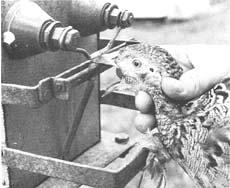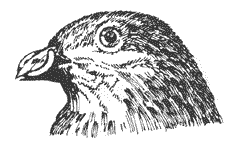
Disease control, parasites, predators and cannibalism in pheasants
Pheasants are hardy birds and usually are not affected by severe outbreaks of disease. The main diseases likely to affect pheasants are coccidiosis and blackhead. If outbreaks of these diseases are prevalent, preventive drugs can be added to the ration. Alternatively, outbreaks can be treated with drugs in the drinking water.
Diseases can be kept to a minimum by good sanitation, prevention of overcrowding and the adoption of other good husbandry practices. Ensure all new stock introduced from another flock are disease-free.
Before selecting any preparation for treatment of birds, it is important to ensure that the preparation is registered under the Stock Medicines Act 1989 or the Pesticides Act 1999 for the particular purpose for which it is to be used.
ALWAYS READ THE LABEL
Users of agricultural (or veterinary) chemical products must always read the label and any Permit before using the product, and strictly comply with the directions on the label and the conditions of any Permit. Users are not absolved from compliance with the directions on the label or the conditions of the Permit by reason of any statement made or not made in this publication.
Internal and external parasites must be controlled regularly; if not, flock performance will suffer.
Internal parasites
The large roundworm (Ascaridia galli) is the most common worm affecting poultry. While there are different schools of thought regarding the degree of harm caused by roundworms, all agree that growth and performance suffer if roundworms are not controlled.
Treatment with medicines registered for the purpose is very effective in controlling roundworms. Medicines can be given to flocks in the feed or drinking water. Administration via the drinking water is recommended because the total required dosage can be given in only a few hours. The dose rate varies with the compound used.
Growing stock will probably only need deworming once, when about 10–12 weeks old. Breeding stock should be dosed when selected and then about every 4 months. More frequent dosage may be necessary if birds are found to contain large numbers of worms.
Other worms that can infect pheasants include the caecal worm (Heterakis gallinea), capillaria worms (Capillaria spp.) and tapeworms, of which there are several species. It is not necessary to treat birds for these worms unless an infestation occurs.
External parasites
Lice are the most common external parasite of pheasants. There are a number of different types of lice, the most common being body lice. Lice can live only when on the bird; they die when they are separated from their host.
Apart from affecting the general thriftiness of pheasants, lice will also cause reduced weight gains and egg production.
Before selecting a preparation to treat lice, make certain it is registered under the Stock Medicines Act 1989 for use on poultry.
The red mite (Dermanyssus gallinae) is the mite most likely to trouble pheasants. Mites are very small, only just visible to the naked eye. They live in crevices of woodwork in buildings and feed on the pheasants at night.
To control mites, paint woodwork with a wood-preserving oil, and spray the building with an insecticide registered for this purpose.
Pheasants are very prone to attack by predators, particularly foxes.
To prevent pheasants becoming frightened and damaging themselves, always keep pet dogs and cats away from the birds. Normally placid domestic dogs have been known to kill dozens of pheasants after going on a rampage.
Pheasants are much more prone to cannibalism and feather picking than other poultry. The beaks of pheasants are particularly sharp. If left untouched, they can do much damage in a relatively short period of time, often resulting in many birds being picked to death. Once an outbreak of cannibalism or feather picking occurs, it is very difficult to stop it. Cannibalism can start in a flock of pheasant chicks 2 weeks of age.
The underlying causes of cannibalism and feather picking are not really known, but the habit is aggravated by overcrowding, poor ventilation and boredom. There are a few management practices that can reduce outbreaks of cannibalism. These include:
- providing dim lighting for birds raised intensively, and plenty of vegetation for birds raised on range
- making sure all buildings are well ventilated and that no overcrowding occurs
- giving birds some hanging bundles of straw to pick at to prevent boredom
- where possible, providing birds with a ration containing adequate levels of salt (0.5%) and fibre (7%);providing perches in houses and shelter sheds.
Unfortunately, these practices will only help reduce the incidence of cannibalism. The only effective method of controlling this vice is to beak trim the birds.If an outbreak of cannibalism has occurred, isolate birds which have been pecked, in order to prevent further wounding. Paint the damaged area with either a commercial anti-peck solution or with substances such as triple dye or stockholm tar.Fitting rings or solid plastic spectacles or blinkers can be useful in preventing cannibalism.

Beak trimming is an operation that removes part of the upper mandible. Modern beak-trimming equipment makes the operation a relatively simple one. Automatic and manually operated machines that also cauterise the beak are available.
- The severity of beak trimming varies, depending on the methods used. As a guide, remove approximately one-third of the top beak.
- Since beaks grow quickly, frequent trimmings will be necessary. Beak trim chicks at 4 and 8 weeks of age, then again every 4–6 weeks as required.
- At the start of and during the breeding season, males tend to become aggressive, and fighting causes damage to birds and often death. Fighting between cocks will be minimised if cocks that are to be used together in a breeding pen are kept together just before mating starts. Beak trim breeding stock as required. Trim the bottom beak as well if it becomes too long.

A ring is placed in the bird’s mouth on top of the tongue so that the points of the rings fit in the bird’s nostrils (see illustration at right). The ring is then clamped firmly together with a pair of pliers.
A ring does not harm or hurt the bird; it enables the bird to perform normal functions such as eating and drinking, but prevents the points of the beak coming together.
It is necessary to choose the correct-sized ring for the age of the birds. Rings can be fitted to chicks at about 4 weeks of age, and these will be suitable for birds until marketing at about 16 weeks of age. If birds are to be kept for breeding, remove the ring with wire cutters and fit an adult-sized ring at 16 weeks.
Plastic spectacles fitted to nostrils of birds have been used successfully to prevent cannibalism but they are relatively expensive and take longer to fit than rings. They also tend to get caught on feeders and other objects and are often pulled off. Fertility is usually low when spectacles are fitted to breeding stock.
Spectacles should only be used as a last resort when other preventative measures have failed to control cannibalism.

